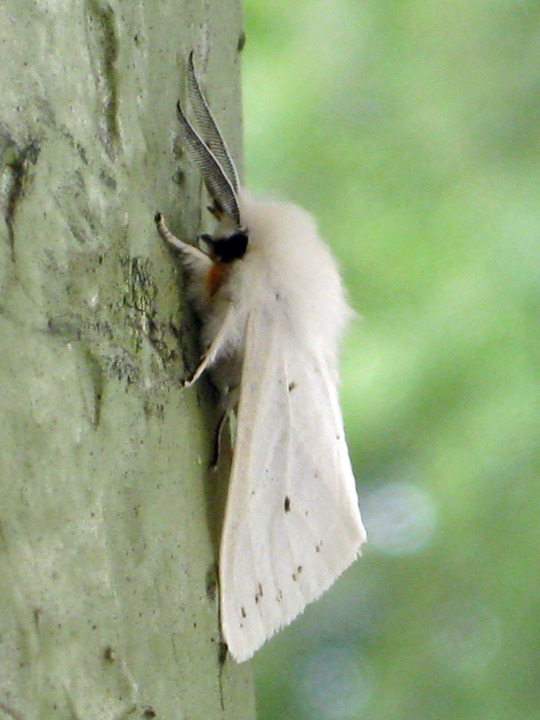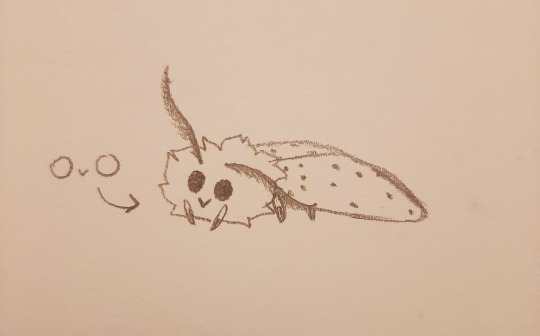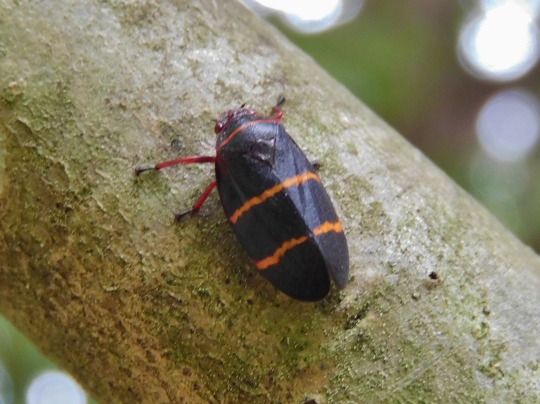#Hyphantria cunea
Text

White Fuzzy Caterpillar on Grass
Fuzzy white bristles glint in the light of the sun as this fall webworm caterpillar ventures up a blade of grass.
See more of my work: Check out my archive.
Join me on my journey: Follow me on tumblr.
Support my creative life: Buy me a coffee on KoFi.
#nature#photography#animals#bugs#insects#moths#fall webworm#moth#lepidoptera#hyphantria cunea#white#fuzzy#caterpillar#grass#garden#scenery#naturecore#beautiful nature#mother nature#texas nature
9 notes
·
View notes
Text
Moth of the Week
Fall Webworm
Hyphantria cunea

The fall webworm is in the family Erebidae. Described by Dru Dury in 1773, this moth is known for creating webbed nests as caterpillars and living in them until the pupa stage. They are considered pests in some areas due to their tendency to defoliate trees while feeding as larva and are known as an invasive species in East Asia.
Description Adult moths are mostly white in color with white legs that are black/brown and white in color. The top two legs are orange on the segment closest to the body. Under the eyes are patches of the same orange color and on occasion there are orange spots on the abdomen. In the north, the wings are completely white while in the south, the wings are speckled with brown or black spots.
Average wingspan: 38.5 mm (≈1.5 in)
Diet and Habitat The fall webworm feeds on just about any type of deciduous tree and can defoliate entire beaches or trees. In the eastern U.S., these moths prefer pecan trees, black walnut, American elm, hickory, fruit trees, persimmon, and sweetgum. In the west, alder, willow, cottonwood and fruit trees are commonly eaten. Adult moths do not feed.
This species is native to North America, ranging from Canada to Mexico, was introduced into other continents in the 1940s, and has since then spread. First recorded in 1949, this moth was introduced to the former nation of Yugoslavia and spread from France to the Caspian Sea and further into central Asia: Turkmenistan, Uzbekistan, Kyrgyzstan, and southeastern Kazakhstan. When introduced to Japan in 1945, it spread to generations per year since its arrival.[5] It spread into China, southern Mongolia, Korea and southern Primorsky Krai of Russia. Now it is considered holarctic, meaning found in almost all regions of the Northern Hemisphere.
Mating The mating season starts in late June and lasts until early July. In the northern part of North America, this species has one generation per year. The larvae hatch and live in late summer through early fall. In the south, which is cons to be under an approximate latitude of 40°N, there are two or more generations annually and nests appear progressively earlier the further south you go. Male fall webworms are typically only available for mating for about 30–60 minutes per day. This moth even shows a form of fall parental behavior. The female will try to protect the eggs after oviposition by covering her newly laid eggs with her abdomen hairs. Females lay the eggs on the underside of the host plants’ leaves in groups of about 100.
Predators The fall webworm has many predators such as Monomorium minimum, Vespula spp., Coleomegilla maculata, and Rogas hyphantriae.This species is parasitized by around 50 species, such as the flies Musca domestica and Muscina stabulans, and parasitic wasps such as Chouioia cunea and Therion morio. There are also several species of microsporida (unicellular spore parasites) such as Nosema necatrix Kramer, Weiser, and Nosema bombycis that are harmful. This species is also harmed by several viruses such as granulovirus and nucleopolyhedrosis virus. The caterpillars protect and defend themselves by shaking and jerking together, giving off a repellant scent, and irritants on their hairs or spines.
Fun Fact The fall webworm is a social insect as groups of caterpillars live in spun nests made from webs. These webs have many benefits like finding of mates, temperature regulation, increased growth rate, and protection from predators. However they also result in higher rates of infections and predation.
(Source: Wikipedia, USDA Forest Service, Missouri Department of Conservation)

@turkeygamemaster
#libraryofmoths#animals#bugs#facts#insects#moth#mothoftheweek#lepidoptera#fall webworm#Hyphantria cunea#Erebidae
24 notes
·
View notes
Note
Saw your request for stuff to draw with your tablet charger dead
What about a fluffy moth?
Those are always cute

OvO ass bitch
anyways, korn i want you to know when i saw this ask i had already put all my stuff away (after finishing a thing that'll be posted tomorrow) but i IMMEDIATELY grabbed it all again to draw this little guy. enjoy your fall webworm moth. i love her
#moth#moth art#fall webworm moth#hyphantria cunea#ask function being used#hey look art#kornwulf#also i have seen ur second ask and i will get to it. if it gets posted it'll be tomorrow tho i just got excited for this guy lol
9 notes
·
View notes
Text



Privileged & honored to host a H. cunea brood in my front yard right now. Got home from dinner to find a writhing crop of yellow beaftes in the awaiting me!
4 notes
·
View notes
Text


fall webworm moth
5 notes
·
View notes
Text


Fall Webworm Moth
Hyphantria cunea
Erebidae
Photographs taken on August 13, 2023, at Pinery Provincial Park, Ontario, Canada.
#wildflowers of southern ontario#moth#caterpillar#Fall Webworm Moth#Fall Webworm caterpillar#Hyphantria cunea#Hyphantria#Erebidae#nature#web#Pinery Provincial Park#provincial park#ontario#canada
3 notes
·
View notes
Note
I do not think you have done this one yet, but can you do the Fall Webworm Moth? They are the reason I love moths so much now ^^
Moth Of The Day #138
Fall Webworm
Hyphantria cunea
From the erebidae family. They have a wingspan of approximately 30 mm. They are native to North America but have also been introduced to Asia.


#moth#moths#lepidopterology#lepidoptera#pretty moth#nature#insect#bugs#moth of the day#motd#insects#bug#bugblr#lepidoptery#entomology#fall webworm#fall webworm moth#erebidae#erebidae moth
247 notes
·
View notes
Text





A few Insecty/Buggy pics from the day...
A Black Carpenter Ant (probably: Camponotus pennsylvanicus) dragging off a long dead Fall Webworm (Hyphantria cunea).
Likely a Banded Tussock Moth caterpillar (Halysidota tessellaris).
Candy-Striped Leafhopper (Graphocephala coccinea).
And 2- Two-Lined Spittlebugs (Prosapia bicincta).
#nature#my photography#insects#caterpillars#tussock moth#nature photography#spittlebugs#leafhopper#backyard nature#wildlife photography#bugs
45 notes
·
View notes
Text
Corkscrew Swamp Bug Hunt pt 1/3
I was here with my pal @geraldsavesflorida on a cold February morning at the end of a big storm, and although we spent a lot of time marveling at all the rare plants and gorgeous views, you know my favorite parts were the bugs we found along the way!
🔎Hyphantria cunea / fall webworm moth
🐛
🌱
💚
#bugs #entomology #entomologist #caterpillar #moths #fallwebworm #southflorida #naples #corkscrewswamp #audubon #florida #insects #naplesfl #paradisecoast
@corkscrewswamp @paradisecoast

2 notes
·
View notes
Text

Fall Webworn Moth (Hyphantria Cunea)
#moths and butterflies#insects#moth tag#insect#luna moths#moths art#animals are awesome#aesthetic#so beautifuuuul#nature aesthetic#animal friends#fauna#art
30 notes
·
View notes
Text
Back on my hyperfixation shenanigans so I have not slept and here's a list of what I consider to be the prettiest beetles, butterflies and moths, damselflies, and grasshoppers and crickets that inhabit Colorado and Kentucky according to insectidentification.org :
COLORADO
Emerald ash borer (Agrilus planipennis)
Fifteen-spotted lady beetle (Anatis labiculata)
Golden tortoise beetle (Charidotella sexpunctata)
Knapweed root weevil (Cyphocleonus achates)
Longhorn beetle (Semanotus amethystinus)
Dogbane Leaf Beetle (Chrysochus auratus)
European Ground Beetle (Carabus nemoralis)
Golden Net-wing Beetle (Dictyoptera aurora)?
Margined Blister Beetle (Epicauta funebris)
May Beetle - P. lanceolata (Phyllophaga lanceolata)
Mottled Tortoise Beetle (Deloyala guttata)
Pleasing Fungus Beetle (Gibbifer californicus)
Poplar Borer Beetle (Saperda calcarata)
Shining Leaf Chafer - Anomala spp. (Anomala spp.)
Signate Lady Beetle (Hyperaspis signata)
American Lappet Moth (Phyllodesma americana)
Cinnabar Moth (Tyria jacobaeae)
Common Checkered-Skipper (Pyrgus communis)
Glover's Silkmoth (Hyalophora columbia gloveri)
Great Ash Sphinx Moth (Sphinx chersis)
Autumn Meadowhawk (Sympetrum vicinum)
Black Saddlebags Skimmer (Tramea lacerata)
Bird Grasshopper (Schistocerca spp.)
Obscure Bird Grasshopper (Schistocerca obscura)
Sooty Longwing Katydid (Capnobotes fulginosus)
KENTUCKY
Andrew's Snail-eating Beetle (Scaphinotus andrewsii)
Black Firefly (Lucidota atra)
Calligrapha Beetle (Calligrapha spp)
Eastern Hercules Beetle (Dynastes tityus)
Emerald Euphoria Beetle (Euphoria fulgida)
Glowworm (Phengodes spp.)
Goldsmith Beetle (Cotalpa lanigera)
Metallic Wood-boring Beetle: Chalcophora (Chalcophora fortis)
Notched-mouth Ground Beetle (Dicaelus purpuratus)
One-spotted Tiger Beetle (Apterodela unipuncata)
Rainbow Darkling Beetle (Tarpela micans)
Rainbow Scarab Beetle (Phanaeus vindex)
Six-spotted Tiger Beetle (Cicindela sexguttata)
Southern Sculptured Pine Borer Beetle (Chalcophora georgiana)
Stag Beetle (Lucanus capreolus)
Twice-stabbed Lady Beetle (Chilocorus stigma)
Vietinghoff's Ground Beetle (Carabus vietinghoffii)
Abbott's Sphinx Moth (Sphecodina abbottii)
American Ermine Moth (Yponomeuta multipunctella)
Arched Hooktip (Drepana arcuata)
American Bird's-Wing Moth (Dypterygia rozmani)
Arcigera Flower Moth (Schinia arcigera)
Attentive Crocus Moth (Xanthotype attenuaria)
Basswood Leafroller (Pantographa limata)
Beautiful Wood-Nymph (Eudryas grata)
Black-waved Flannel Moth (Megalopyge crispata)
Blackberry Looper (Chlorochlamys chloroleucaria
Blinded Sphinx Moth (Paonias excaecata)
Bluish Spring Moth (Lomographa semiclarata
Buck Moth (Hemileuca maia)
Carmine Snout Moth (Peoria approximella)
Carrot Seed Moth (Sitochroa palealis)
Cecropia Silk Moth (Hyalophora cecropia)
Changeable Grass-Veneer (Fissicrambus mutabilis)
Colorful Zale (Zale minerea)
Common Lytrosis Moth (Lytrosis unitaria)
Confused Eusarca (Eusarca confusaria)
Cross-lined Wave (Timandra amaturaria)
Curve-toothed Geometer (Eutrapela clemataria)
Dark-banded Geometer (Ecliptopera atricolorata)
Deep Yellow Euchlaena (Euchlaena amoenaria)
Diaphania costata (Diaphania costata
Dimorphic Macalla (Epipaschia superatalis)
Dot-lined White (Artace cribrarius)
Dotted Gray (Glena cribrataria)
Drab Prominent (Misogada unicolor)
Eight-spotted Forester Moth (Alypia octomaculata)
Elder Shoot Borer (Achatodes zeae)
Explicit Arches (Lacinipolia explicata)
Eyed Paectes Moth (Paectes oculatrix)
Falcate Orangetip (Anthocharis midea) (female)
Fall Webworm (Hyphantria cunea)
False Crocus Geometer (Xanthotype urticaria
Fervid Plagodis (Plagodis fervidaria)
Fig Sphinx (Pachylia ficus)
Friendly Probole Moth (Probole amicaria)
Giant Leopard Moth (Hypercompe scribonia)
Goldcap Moss-eater Moth (Epimartyria auricrinella)
Gray-edged Hypena (Hypena madefactalis)
Green Arches (Anaplectoides prasina)
Hag Moth (Phobetron pithecium
Hibiscus Leaf Caterpillar Moth (Rusicada privata)
Imperial Moth (Eacles imperialis)
Lesser Maple Spanworm Moth (Speranza pustularia
Luna Moth (Actias luna)
Melissa Blue Butterfly (Plebejus melissa spp.)
Modest Sphinx Moth (Pachysphinx modesta)
Morbid Owlet Moth (Chytolita morbidalis)
Orange-patched Smoky Moth (Pyromorpha dimidiata)
Pale Beauty (Campaea perlata)
Pale Lichen Moth (Crambidia pallida)
Pale Metarranthis (Metarranthis indeclinata)
Pandorus Sphinx Moth (Eumorpha pandorus)
Parthenice Tiger Moth (Apantesis parthenice)
Pearly Wood-Nymph Moth (Eudryas unio)
Pero Moth (Pero spp.)
Pink-patched Looper (Eosphoropteryx thyatyroides)
Pipevine Swallowtail (Battus philenor)
Pistachio Emerald Moth (Hethemia pistasciaria)
Plebeian Sphinx Moth (Paratrea plebeja) (Caterpillar)
Primrose Moth (Schinia florida)
Promiscuous Angle Moth (Macaria promiscuata)
Raspberry Pyrausta (Pyrausta signatalis)
Rustic Sphinx Moth (Manduca rustica)
Saddleback Caterpillar Moth (Acharia stimulea)
Saddled Yellowhorn (Colocasia flavicornis)
Salt-and-pepper Looper Moth (Syngrapha rectangula)
Satin Moth (Leucoma salicis)
Scarlet-winged Lichen Moth (Hypoprepia miniata)
Schlaeger's Fruitworm Moth (Antaeotricha schlaegeri)
Showy Emerald Moth (Dichorda iridaria)
Small Bird Dropping Moth (Ponometia erastrioides)
Snowy Urola (Urola nivalis)
Sorghum Webworm Moth (Nola cereella)
Southern Flannel Moth (Megalopyge opercularis)
Southern Longhorn Moth (Adela caeruleella)
Southern Pine Sphinx (Lapara coniferarum)
Southern Tussock Moth (Dasychira meridionalis)
The Badwing (Dyspteris abortivaria)
Unspotted Looper Moth (Allagrapha aerea)
Venerable Dart Moth (Agrotis venerabilis
Vine Sphinx Moth (Eumorpha vitis)
Walnut Sphinx Moth (Amorpha juglandis)
Wavy-lined Emerald Moth (Synchlora aerata)
Western Grapeleaf Skeletonizer Moth (Harrisina metallica)
White Flannel Moth (Norape ovina)
White Slant-line Moth (Tetracis cachexiata)
White-fringed Emerald Moth (Nemoria mimosaria)
Yucca Moth (Tegeticula, Greya, and Prodoxus spp.)
Carolina Locust (Dissosteira carolina)
Eastern Shieldback Katydid (Atlanticus spp.)
Slender Meadow Katydid (Conocephalus fasciatus)
True Katydid (Pterophylla camellifolia)
Ebony Jewelwing (Calopteryx maculata)
Midland Clubtail (Gomphurus fraternus)
Red Saddlebags (Tramea onusta)
Seepage Dancer (Argia bipunctulata)
5 notes
·
View notes
Text


Fall Webworm (larva/caterpillar), Hyphantria cunea
5 notes
·
View notes
Text

Fall Webworm Moth (Hyphantria cunea)
1 note
·
View note
Text
Des images de chenilles provenant d'applications sur la nature ont permis à des chercheurs d'étudier l'émergence d'une nouvelle espèce de chenille
See on Scoop.it - EntomoNews
Crowd-sourcing images of caterpillars from nature apps allowed researchers to study the emergence of a new species of caterpillar.
Crowd-sourced science sheds light on how new species form across space and time
Katie Marshall, University of British Columbia et Emily Black, University of British Columbia
The fall webworm is a moth found from Mexico to Canada. (Shutterstock)
-------
NDÉ
Traduction
Imaginez une jungle. Il s'agit probablement d'une forêt luxuriante, remplie de chants d'oiseaux et du bourdonnement de milliers d'insectes différents. Imaginez maintenant une toundra : un terrain stérile, balayé par le vent, avec relativement peu d'espèces de plantes ou d'animaux.
Ces deux lieux mettent en évidence un phénomène intéressant : certains endroits de la Terre comptent beaucoup plus d'espèces que d'autres. En fait, la répartition des espèces sur le globe suit un schéma curieusement cohérent : en général, il y a plus d'espèces près de l'équateur et moins à mesure que l'on se rapproche des pôles. Ce "gradient latitudinal de biodiversité" peut être observé dans de nombreux groupes d'organismes différents au fil du temps.
L'une des explications possibles de la présence d'un plus grand nombre d'espèces près de l'équateur est que les changements climatiques entre l'équateur et les pôles affectent la capacité de nouvelles espèces à évoluer - un processus appelé spéciation.
La diversité en action
Notre équipe de recherche de l'université de Colombie-Britannique a fait appel à des outils et à des espèces uniques pour déterminer exactement comment le climat influe sur l'évolution et ce que cela signifie pour l'apparition de nouvelles espèces. Et nous avons mené ces recherches alors que nous étions bloqués à la maison pendant le COVID-19.
(...)
L'étude
Crowd-sourced observations of a polyphagous moth reveal evidence of allochronic speciation varying along a latitudinal gradient | PLOS ONE, 13.07.2023 https://journals.plos.org/plosone/article?id=10.1371/journal.pone.0288415
Compléments sur l'espèce
The Great Webworm Hunt · iNaturalist
https://www.inaturalist.org/projects/the-great-webworm-hunt
r/K‐like trade‐off and voltinism discreteness: The implication to allochronic speciation in the fall webworm, Hyphantria cunea complex (Arctiidae) - Yang - 2017 - Ecology and Evolution - 4.11.2017 https://onlinelibrary.wiley.com/doi/10.1002/ece3.3334
Bernadette Cassel's insight:
Crowd-sourcing images of caterpillars from nature apps allowed researchers to study the emergence of a new species of caterpillar.
0 notes
Text
Managing Fall Webworm Infestations
Managing Fall Webworm Infestations
Mario Villarino, DVM, Ph.D., Hopkins County Extension Agent
By Mario Villarino, Texas AgriLife Extension Agent, Ag/Natural Resources, Hopkins County, [email protected]
The fall webworm, Hyphantria cunea (Drury), is native to North America and is a common caterpillar pest of trees. It attacks more than 88 kinds of plants in North America, including many fruit, nut, and ornamental trees…

View On WordPress
0 notes
Text


Hey!
Here is photo I took from a while ago of some random caterpillar that fell on to my friend's leg :D
I believe it's Hyphantria cunea, but feel free to correct me
It's some kind of moth and really pretty one
Anyway, enjoy this little beauty
See ya soon ;)
#Hyphantria cunea#moth#caterpillar#larva#animal#creature#photo#animals#beauty#leg#hairy#random#bugs#bug#insects#insect#nature
4 notes
·
View notes